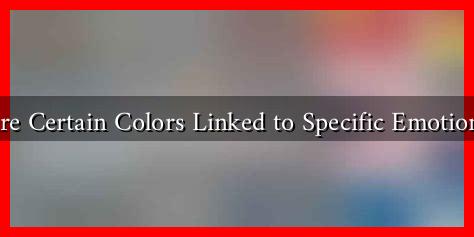-
Table of Contents
Are Certain Colors Linked to Specific Emotions?
Color psychology is a fascinating field that explores how colors influence human emotions and behaviors. From the calming blues of a serene sky to the passionate reds of a fiery sunset, colors can evoke a wide range of feelings. This article delves into the relationship between colors and emotions, examining how different hues can impact our mood, perception, and even decision-making.
The Science Behind Color and Emotion
Color perception is not merely a subjective experience; it is deeply rooted in psychological and physiological responses. Research has shown that colors can trigger emotional reactions based on cultural associations, personal experiences, and even biological factors. For instance, a study published in the journal *Color Research and Application* found that warm colors like red and yellow tend to evoke feelings of warmth and comfort, while cool colors like blue and green are often associated with calmness and tranquility.
Common Color Associations
While individual experiences may vary, certain colors are commonly linked to specific emotions. Here are some prevalent associations:
- Red: Often associated with passion, love, and anger. It can stimulate energy and increase heart rates.
- Blue: Typically linked to calmness, trust, and sadness. It is often used in corporate branding to convey reliability.
- Yellow: Associated with happiness, optimism, and creativity. However, excessive yellow can lead to feelings of anxiety.
- Green: Represents nature, growth, and tranquility. It is often used in spaces designed for relaxation.
- Purple: Linked to luxury, spirituality, and mystery. It can evoke feelings of creativity and inspiration.
- Black: Often associated with power, elegance, and mourning. It can evoke strong emotions depending on the context.
- White: Represents purity, simplicity, and innocence. It can create a sense of space and cleanliness.
Case Studies and Real-World Applications
Understanding the emotional impact of colors has practical applications in various fields, including marketing, design, and therapy. Here are a few examples:
- Marketing: Brands often use color strategically to influence consumer behavior. For instance, McDonald’s uses red and yellow to create a sense of urgency and stimulate appetite, while companies like Facebook use blue to convey trust and reliability.
- Interior Design: Color choices in home decor can significantly affect mood. For example, a study by the University of Texas found that people in blue rooms reported feeling more relaxed than those in red rooms.
- Art Therapy: Therapists often use color as a tool for expression and healing. Patients may be encouraged to use specific colors to represent their feelings, helping them articulate emotions that may be difficult to express verbally.
Statistics on Color and Emotion
Several studies have quantified the impact of color on emotions. According to a survey conducted by the Institute for Color Research, people make a subconscious judgment about a person, environment, or product within 90 seconds of initial viewing, and between 62% to 90% of that assessment is based on color alone. This statistic underscores the importance of color in shaping perceptions and emotional responses.
Cultural Variations in Color Perception
It is essential to note that color associations can vary significantly across cultures. For example, while white is often associated with purity and weddings in Western cultures, it is linked to mourning in some Eastern cultures. Understanding these cultural nuances is crucial for effective communication and design in a globalized world.
Conclusion
Colors play a vital role in shaping our emotions and perceptions. While certain colors are commonly linked to specific feelings, individual experiences and cultural contexts can influence these associations. By understanding the psychology of color, we can harness its power in various aspects of life, from marketing to personal well-being. Whether you are designing a space, creating a brand, or simply choosing an outfit, being mindful of color can enhance emotional resonance and communication.
For further reading on color psychology, you can explore resources like the Color Psychology website, which offers in-depth insights into how colors affect our emotions and behaviors.

